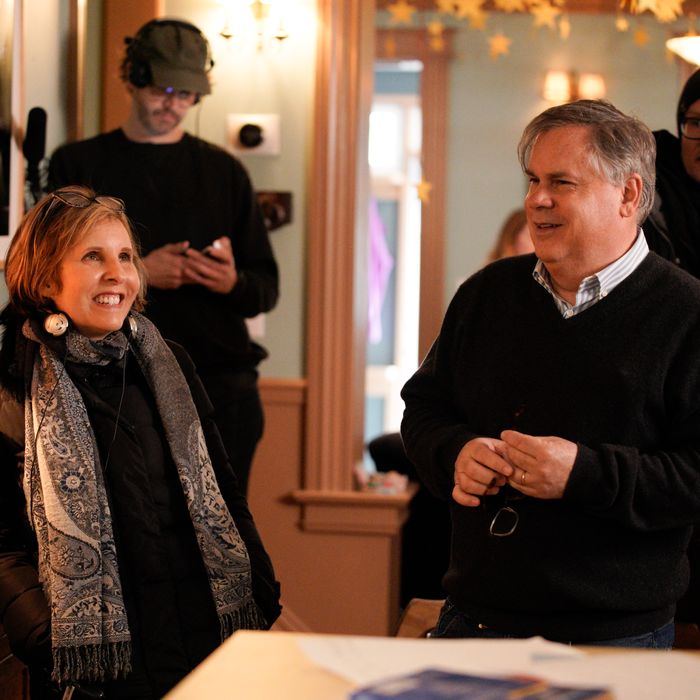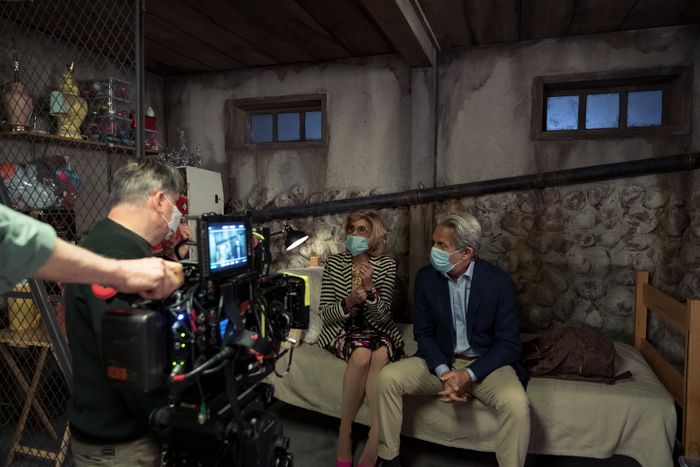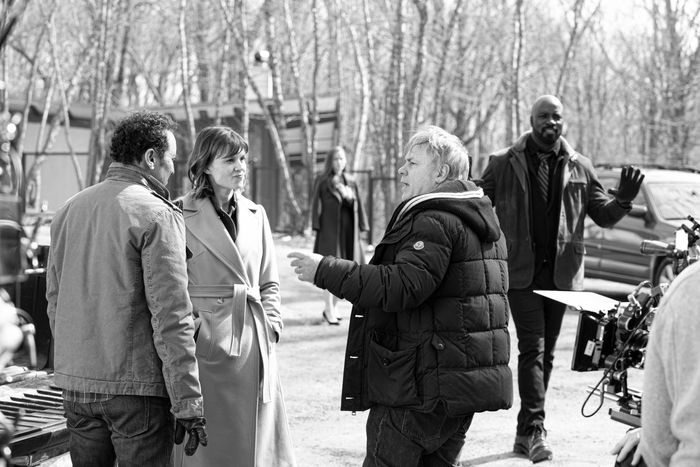
At first blush, Evil is a sort of Catholic-inflected X-Files. The blisteringly entertaining supernatural drama, which concluded its second season this month, is filled with imagery and moments that pierce the imagination: Brains splattered on a gilded pop-up book. A decaying body, split at the center, pulling herself along the floor by scraping fingernails. A sleep demon, with gnarled skin cast in inky blue shadow, taking out her retainer before going down on a man.
But then there are moments like the one in this season’s “C Is for Cop,” in which an officer shoots a Black mother in her car when she reaches for her cell phone. She’s dead before a word can escape her lips. Panicked, Officer Jim Turley (Corey Cott) turns to the Catholic church for help — he wants to plead temporary insanity before the grand jury. The reason? He believes he was momentarily possessed by a demonic influence that warped his vision, making him see a gun where there was a cell phone.
At the center of Evil is Dr. Kristen Bouchard (Katja Herbers), a forensic psychologist who is hired by David Acosta (Mike Colter), a former journalist studying to be a priest, to help him distinguish between actual instances of demonic possession and insanity. Kristen is skeptical, but finds herself in situations that science cannot explain. She works alongside Ben (Aasif Mandvi) — a lapsed Muslim tech contractor who shares Kristen’s cynicism — to investigate supernatural occurrences for the Catholic church.
The cop scene is nestled in the more pivotal plot of the episode: Kristen is freed from her own, season-long struggle to evade the police after killing a serial killer named LeRoux (Darren Pettie). She’s able to escape repercussions — despite being found in her backyard holding the murder weapon after calling her cop buddy Detective Mira Byrd (Kristen Connolly) — for a single reason: She’s a white woman. The episode leaves her crying in her backyard, looking diminished and small. Something about this image got under my skin. It simultaneously harkened toward the apocalyptically biased systems in effect in this country and handily let its lead off the hook for her transgression. The Kristen and officer story lines play off one another, gesturing at the ways in which white identity protects itself. It’s the kind of gamble showrunners Michelle and Robert King, who have been married since 1987, have grown increasingly adept at over their tenure as producers and writers of television — particularly since The Good Wife began in 2009, and its 2017 spinoff, The Good Fight, starring Christine Baranski as Diane Lockhart, a white lawyer who lands at a Chicago-based, Black law firm after losing her life savings, launched.
The Kings use the procedural form to tell urgent stories about the structures of power that shape our lives. At their best, they fold topical discussions into propulsively structured, highly entertaining episodes that play with expectations in form, style, and narrative. Robert says their attraction to the procedural was at first a matter of circumstance. “When the writers’ strike happened, going way back then to 2008, we were force-majeured at the studio we were at and CBS was interested,” he said from their home in California last year. (The Kings returned to New York this year, where their writers’ rooms are based.) Michelle adds, “Television just lends itself to procedural storytelling. If you’re going to tell a purely serialized story, it’s hard to do it over that many episodes and not become melodrama.” She points to Scandal, a series that frequently left reality behind. “We have been unwilling to leave reality behind.”
Robert has the rumpled mien of a passionate but kindly college professor; he is a staunch Catholic and to the center politically. Michelle comes from a Jewish background and is further to the left. She’s the more exacting of the two. Behind the scenes, Michelle is the structuralist, while Robert homes in on the visuals and dialogue. When I would ask questions, they would look at one another, holding each other’s gaze for several seconds, as if silently communicating before shaping an answer. The sharpness of their intellect and curiosity comes through clearly in conversation. Robert name-checks David Lynch and the visuals of the Charles Laughton–directed 1955 noir masterpiece The Night of the Hunter as influences on Evil. Robert directed the show’s mostly silent episode this season, which takes place in a monastery. He discusses the choice to pay attention to vertical space in the frame, a way for the show to always be considering and pointing toward the heavens.
The Kings absorb the news voraciously through written outlets like the Washington Post and the New York Times, but they don’t typically watch it. “Every day in the room on The Good Fight, we spend between 30 and 60 minutes just talking about what we’ve been reading in the news the night before,” Michelle explains. Robert subscribes to the National Review in order to “get a sense of where things are headed.” He thrives when he’s thinking through tangled ideas — the more polarizing, the better. Michelle is the peacemaker, the one who raises questions about their most audacious decisions. “One of the ways that expresses itself on the page is in the power of two people with opposite points of view expressing them, and the audience hopefully coming out of it not knowing which one necessarily is true,” Robert says.
Even then, there are stories they won’t touch. “I don’t like rape stories because they’re binary,” Michelle says. “It’s typically, ‘She was raped or she was lying,’ and I’m not interested in telling stories about women that lie about rape. We also stay away from immigration stories because they tend to be earnest and earnest is not our sweet spot.” An episode they could never wrangle into the proper shape involved Israel and the BDS (Boycott, Divestment, Sanctions) movement to end the occupation of Palestine. It would have seen a clash between the Jewish and Black lawyers at Reddick, Boseman, & Lockhart, while also involving a famous singer character trying to back out of her contract to perform in Israel.
“It was a very interesting story and here’s the problem,” Robert says. “Our writers’ room was ready to rip each other’s throats out over this subject.”
“People were just screaming at each other,” Michelle says. “We like to live in the gray, and it didn’t feel like we were living in the gray. It doesn’t mean we won’t tell that story eventually, but we didn’t find the nuanced version.”
“I was probably the most pro-Israel,” Robert adds.
When I spoke with Nialla LeBouef, the youngest writer in Evil’s room who is credited with this season’s “U Is for UFO” episode, she described the writers’ room as a classroom of sorts, with Robert at the head; writers raise their hands and are called on to throw out story ideas. “Every draft is group-written,” Robert explains. “The writer of record does a polish of that, then it goes to us, and typically, it’s drastically rewritten,” Robert adds. “That isn’t the case on every show.”
Sometimes their writers and actors push back. On Evil last season, Michael Emerson, who plays the conniving and demonically aligned antagonist Leland Townsend, wanted to downplay the extremities of an incel story line, which originally contained a high body count, worrying about what it might inspire. During the first season, they planned to do an episode inspired by Nate Parker, the embattled director of 2016’s Birth of Nation; a rape accusation from his college years resurfaced and derailed what seemed to be a sure critical hit. Lead actor Delroy Lindo (who has since left the series) voiced his concerns. “Delroy was worried that kind of plot hurts Black men, especially Black young men,” Robert recalls. “He was showing that there was another implication of it that I think was us going maybe a little too far out on the limb.” Michelle adds, “It’s one of the few times we’ve had to junk an episode written.”
This past season of The Good Fight, Baranski didn’t agree with a major plot turn for her character. Baranski isn’t just close to the Kings as collaborators; she counts them as friends: She often sees Robert at Catholic mass on Sunday afternoons, and they walk back to their nearby homes together. On the show, the Kings had planned to sever the marriage between liberal feminist Diane and her intensely conservative but loving husband Kurt (Gary Cole). The plot would see Diane deem the political differences with Kurt too glaring to bridge, leading her to also leave the firm and start a new one with Julius (Michael Boatman), a Black conservative. “I was shocked by that,” she tells me. “And because I’m so close to the character, it hit me emotionally. I did not want to lose that marriage. I said, ‘That’s kind of simple, isn’t it? And then where do we go?’” The Kings listened and rewrote the episode, leading to a scene where Diane goes to an imaginary Ruth Bader Ginsburg for advice on Kurt and her position at the firm. “Imagine if I could talk to the person I most admire,” Baranski says, “what would she say?”
The Good Fight premiered at the start of the Trump era, and in its early seasons, it felt like a direct reflection of the surreality of the moment. “It started with this idea that the news was becoming so absurd because of all the traditions broken in the White House,” Robert said. “The only way to attack your understanding of the news cycle is to use the surreal because that’s now the world we’re in.” The Kings nudged the storytelling into frequently experimental areas. Characters broke into song. Memory and dream sequences unfurled, becoming tools to explore the dark recesses of the characters’ psyches. In the third-season opener, Trump appeared in the form of a bruise on Diane’s husband’s shoulder. Characters contended with a possibly fake Melania Trump as she mulled a divorce. Cush Jumbo’s Lucca Quinn is harassed by a white woman who doesn’t believe her light-skinned baby is actually hers, and she ends up becoming a meme about mothering while Black. The Kings’ approach feels so novel because no one else on television has the gumption to so forcefully lean into the granular textures of the Zeitgeist.
There are limits to their approach. Their topicality works best when they’re able to balance their tonal high-wire act with a gimlet-eyed perspective on the interior lives of their characters. During the latest, fifth season of The Good Fight, they weren’t always able to find the right balance. (The RBG scene was less revealing than it was ridiculous and arch.) And in many ways, a show like The Good Fight was easier to make in the Trump era because the political figures were so outsize in their villainy. In recent years, both series have taken a thematic interest in interrogating whiteness, primarily through their female leads, to varying degrees of success. Consider the season-four opening of The Good Fight: Diane imagines a world in which Hillary Clinton won the election. As a result, Me Too never happened; progress, it was assumed, had already arrived for women. Season five takes things further. After the Black Lives Matter protests in 2020, Diane’s place as a leader of a Black firm is called into question. Diane is the kind of liberal white woman who praised Hillary Clinton and is assured of her own place in the halls of power. Associates openly wonder why this white woman is a name partner, while Diane believes she worked hard to earn her spot. We aren’t wholly privy to the interior lives of the Black people who critique her position. By the end of the season, Diane realizes the errors in her thinking and chooses to let go of her name-partner status and corner office, while remaining at the firm. “I think I need to prove myself,” she tells Liz in the closing moments of the finale. The plotline tries to skewer white feminism, but never fully implicates its lead; instead, it suggests, she’s an underdog again. After all, Diane isn’t a Trojan horse character, a means to explore the interior lives of the Black people she’s surrounded by in the firm. She is the show’s engine and guiding principle, and she is written as an essentially good person fighting the good fight from the inside.
The season was also hobbled by the loss of its two most prominent Black actors, Delroy Lindo’s Adrian Boseman and Jumbo, who get a truncated send-off in the premiere of the fifth season. Over time, the central premise of the show becomes harder to thread without stronger Black characters and story lines. When I ask about their approach to race, the Kings defer. “I don’t think of the show so much as interrogating whiteness as interrogating liberalism,” Michelle says. Robert points me to the show’s Black writers. “I would basically throw to Davita Scarlett and Aurin Squire, our African American writers in the room, who really grab hold of this,” Robert says. (The Good Fight writers’ room has two Black writers; the Evil room has four.) He admits that he struggles with the question. “We’ll throw up our hands and say, you’re right,” he says. “I don’t know what to do about it. Just know the show is struggling with it because the more things we experience in real life is all brought into the show kicking and screaming. There’s a lot about having white showrunners run a show that deals with African American issues that is complex and troubling.”
Like Diane is to The Good Fight, Kristen is Evil’s engine. In “C Is for Cop,” when Detective Mira Byrd decides to let Kristen go instead of bringing her in for the murder of LeRoux, she tells her, “You’re a good person. You’re a nice suburban mom. What happened to LeRoux was justice. Some people deserve to die. Cops know that better than anyone.” Kristen doesn’t face external repercussions beyond her own self-destructive impulses. The show makes her atonement an interior process: Her guilt manifests physically, through self-flagellation; she burns her torso with a rosary cross repeatedly. Like Diane, Kristen isn’t framed as an anti-hero, but a flawed hero we’re meant to care for.
It’s interesting to look at Evil and The Good Fight side by side. While Evil has the same limitations when it comes to race, it has become the stronger show of the two. The writers never lose sight of the foibles that make the characters human. And while Evil has touched on topical issues, it’s not restricted by them. If The Good Fight has occasionally been hamstrung by its commitment to exploring the events of present American life, Evil is more free to wander, to probe revealing, primal questions about human nature, sin, and desire.
In the closing scene of the finale, David, now officially ordained a priest, listens as Kristen tearily confesses that she murdered LeRoux. “God forgives,” he advises. She hesitates. “I killed a man — I did — LeRoux. I killed him and I got away with it,” she chokes out between sobs before they go through the acts of contrition. Then the scene turns from weepy fearfulness to lustful. After two seasons of teasing their desires for one another, they finally act upon their attraction with a full-bodied kiss. The finale ends before we’re able to witness how far they go. I couldn’t help but gasp.




